Gratitude was always part of her happiness routine, but when Sienna Saint-Cyr started practising yoga for gratitude, she found a new lightness, peace and energy within.
Gratitude – and gratitude yoga – is a catalyst for happiness. When we're grateful for what we have, we stop focusing on the things we lack. But why exactly? Gratitude expert Robert Emmons shares that when people help one another, they feel happier. The actions they take release the feel-good hormone oxytocin. It's this same chemical that positive touch activates. So, while gratitude itself doesn't release the happiness hormone, the actions we take when we are full of gratitude do.
From my personal experience, I know that holding gratitude in my heart and mind always leads me to feel happier. For me, it’s not just the actions I take but the reminder that I have so much to be thankful and appreciative for. That alone can get my thinking from dark and depressed to being full of joy. Gratitude is a vital step in my happiness and the benefits of gratitude practice are many.
Gratitude yoga: what is it?
Since I’d already tried compassion yoga with Adriene, I wanted to try 'Grounding Into Gratitude – Root Chakra Yoga' with her as well. Gratitude – in my experience – is more practical as opposed to just a ‘feeling’, so incorporating it into my yoga practice sounded like an excellent method for increasing my gratitude and, therefore, happiness.
“Gratitude and gratitude yoga is a catalyst for happiness. When we're grateful for what we have, we stop focusing on what we lack.”
Right from the start, Adriene asked that we trust ourselves, her, and the gratitude yoga practice. She opens with a request that we are the ‘observer’. It made perfect sense, since, in order to feel full of gratitude, we have to be able to observe the good happening around us. It takes us from a place of internal focus and allows us to look outward. This video is also shorter than the last, only about 30 minutes. So it’s a good one for those that don’t have a full hour for daily practice.
Gratitude yoga from Adriene
Connecting to chakras
Next, Adriene has the practitioners focus their energy in their root chakra, which is the space right behind the pubic bone. Our root chakra is our base, foundation, our connection to the Earth and the physical. When it's out of balance, we can experience higher levels of negativity, trouble eating, greater insecurity, greediness, and more. With all the negative aspects of the root being out of balance, having a practice that focuses on balance seemed the right choice.
While I mentioned the heart chakra in compassion yoga, I didn't get much into it. But in this case, understanding chakras is helpful as they're often used in yoga to focus on a particular area of the body, an energy flow. The chakras are associated with seven energy points in the body, colours, organs, and they have corresponding yoga poses to help balance them.
Because yoga and balancing the mind, body, and spirit are very connected to the thoughts in our heads, Yoga Journal uses words like ‘imagine’, which took the idea of the chakras from a place of ‘this is real, and therefore we must prove it’ to a place of ‘this is real in my mind and therefore, helpful for visualisations during my practice’.
I mention this because when I go to therapy, we often discuss the differences between things that are proven scientifically and things we simply believe. Belief is powerful; there’s no doubt about it. But science and belief aren't the same. So, if you're new to the idea of chakras and desire a science-based explanation, you might do better with the idea of chakras as visualisations as opposed to actual energy points in the body. For our purposes here, the root is our base and our balance.
Gratitude yoga: the practice
The first gratitude yoga pose in which I felt my energy and grounding – or connection to the earth – was the Malasana pose. It was hard to stay in it at first, as I felt unbalanced. But I kept trying. Slowly, my hips opened. I felt my energy shoot from my root down through the floor and into the earth, then fresh energy back up into me. I visualized this energy, and the more I did so, the sturdier I felt.

Gratitude yoga: Malasana pose
Finally, I was able to stay in the gratitude yoga pose and fully embrace that feeling of balance, which then led to me feeling so much giddy happiness. Because when I feel balanced, I feel like I can trust myself, and that is a vital step in maintaining my joy.
During a variation of Malasana, Adriene has the practitioner work with their feet. She mentions that feet are an essential step in finding grounding. Since my feet often ache, I took what she said to heart and massaged my feet while rocking back and forth in a sort of frog-like squat. It’s close to Malasana, but not quite the same.
“Slowly my hips opened. I felt my energy shoot from my root down through the floor and into the earth, then fresh energy back up into me!”
I found this helped me relax into the more challenging poses later on. If I was struggling with balance, I rubbed the bottoms of my feet for 30 seconds, and I was instantly able to balance more efficiently.
Another gratitude yoga pose I found helpful was called Humble Warrior. I’d done Warrior pose many times, even Peaceful Warrior, but not Humble. I was amazed how much this pose released in my body. All the tension I carry in my shoulders and neck began to loosen, and the longer I maintained the posture, the more I felt the release.

Yoga for gratitude: Humble Warrior pose
Gratitude yoga: 'I am,' and happiness
I can’t deny that when I finished the video that I felt lighter, more grounded, connected to Earth, and at peace with myself. One of the mantras Adriene used — because as she stated in the video, it relates to the root chakra — was ‘I am’.
During the entire session, I focused on gratitude for all the wonderful people in my life, for the healing in myself that I've allowed happening and worked so hard for, and also the thought 'I am'. I kept repeating ‘I am’ in my head. Sometimes I’d say it aloud. Each time, I felt more accepting of myself. Less judgement and self-shaming behaviour for all the things I am not.
I've known about ‘I am’ for years now. In fact, my first introduction to it was when I was young and being raised in a religious household. I was told that this was God’s response when asked what he was. Later I was shown meditations and Native American and Buddhist practices that also incorporated it.
“When I finished the gratitude yoga video I felt lighter, more grounded, connected to Earth, and at peace with myself.”
But I didn't understand that really all ‘I am’ means is acceptance and embracing of the self. It’s not to embrace my bad habits, but to embrace that I have those bad habits and to choose to love myself anyway. It’s in accepting myself fully that I find the ability to break my bad habits. Not only is the mantra ‘I am’ helpful for self-acceptance, but it’s also useful for gratitude toward others, as well as affirmations: I am thankful… I am grateful… I am happy…
Self-acceptance is an important step on our path to happiness. In fact, self-help books and too-large goal setting can lead to unhappiness. There's a ‘should be’ and ‘should do’ mentality and it directly leads to ‘I am not enough’. The right place to start with developing one self though is self-acceptance and being happy enough. While self-acceptance – 'I am' – can result in seeing our worth as we are. As I mentioned above, this isn't reason to perpetuate bad habits. What it is is an opportunity for embracing ourselves and loving who we are.
I feel gratitude, the ‘I am’ mantra, and happiness are connected. I didn't possess any of these until I jumped onto the wheel (as I see it in my mind’s eye). Once I had gratitude, I felt happier. Once I felt happier, I was able to accept the parts of myself that I was judging. Then when I let go of self-judgement, I felt a deeper level of gratitude. If I stay on this wheel, these things feed one another, and I end up feeling each stronger. Give yoga for gratitude a try and also read on for yoga for moodswings, part three of this series. Namaste! ●
Main image: colourbox.com. Other images: Yoga with Adriene
Written by Sienna Saint-Cyr
 Sienna Saint-Cyr is an author, advocate, and the founder of SinCyr Publishing. She speaks at conventions, workshops, and for private gatherings on the importance of having a healthy body image, understanding enthusiastic consent, using sexuality to promote healing, navigating diverse or non-traditional relationships, having Complex PTSD, and more. Sienna loves sharing her journey of healing and finding happiness with her readers. Along with writing erotica and romance, Sienna speaks at conventions, workshops, and for private gatherings on such sex-positive topics as a healthy body image, using sexuality to promote healing, and navigating diverse or non-traditional relationships. She writes for several websites. Find out more.
Sienna Saint-Cyr is an author, advocate, and the founder of SinCyr Publishing. She speaks at conventions, workshops, and for private gatherings on the importance of having a healthy body image, understanding enthusiastic consent, using sexuality to promote healing, navigating diverse or non-traditional relationships, having Complex PTSD, and more. Sienna loves sharing her journey of healing and finding happiness with her readers. Along with writing erotica and romance, Sienna speaks at conventions, workshops, and for private gatherings on such sex-positive topics as a healthy body image, using sexuality to promote healing, and navigating diverse or non-traditional relationships. She writes for several websites. Find out more.
happiness.com | The fine art of being: learn, practise, share
Are you a happiness.com member yet? Sign up for free now to enjoy:
■ our happiness magazine with practical life tips
■ share and support in our happiness forum
■ self-develop with free online classes in our Academy




Join the conversation
You are posting as a guest. If you have an account, sign in now to post with your account.
There are no comments to display.